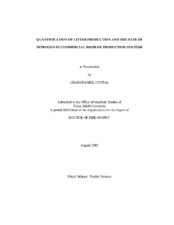| dc.description.abstract | The environmental impacts of broiler production have recently gained
considerable public attention due to concerns regarding the amount of ammonia (NH3)
released into the atmosphere from poultry facilities. Sound scientific data are needed to
accurately estimate the production of manure waste products and gaseous emissions.
This research project was undertaken to quantify nitrogen (N) loss through air emissions
from a broiler grow-out facility over 18 consecutive flocks using the mass balance
method. Measurement of litter and caked litter (cake) mass at the end of each flock
allowed for the calculation of litter and cake production rates for broilers reared on
recycled rice hull litter. Nutrient (nitrogen, phosphorus, and potassium) content of all
litter materials was also measured. Broilers were reared in a research facility under
simulated commercial conditions. All input materials (birds, feed, and litter) used in this
study were obtained directly from a commercial broiler integrator to assure applicability
to the broiler industry. The litter management technique of ??top-dressing?? was also
investigated to determine its effects on N emissions and litter and cake production rates.
Nitrogen emissions, litter and cake production rates, and nutrient density of litter materials were found to vary significantly between flocks reared at different times of the
year. Nitrogen emissions were significantly greater for summer flocks than winter
flocks. Average N loss over all 18 flocks was 11.07 g N/kg of marketed broiler (g
N/kg). Nitrogen partitioning as a percentage of inputs averaged 15.29, 6.84, 55.52, 1.27,
and 21.08% for litter, caked litter, broiler carcasses, mortalities and nitrogen loss,
respectively, over all 18 flocks. Litter and cake production was lower in the summer
compared to winter. Average litter, cake, and all litter (litter + cake) production was
153.3, 74.8, and 228.2 g of dry litter material/kg of marketed broiler. Litter and cake
phosphorus and potassium content was elevated during summer flocks, while litter
material N content decreased in summer flocks. Therefore, season of the year is an
important factor that scientists and broiler producers must take into account when
performing measurements and calculations, sampling litter materials and air emissions,
and developing nutrient management plans. | en |


